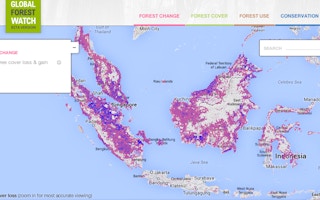The world’s vulnerable trees have found a new guardian in the latest technologies of cloud computing and crowdsourcing with the launch of a ground-breaking tool on Thursday developed by the World Resources Institute (WRI) and Google to help manage forests worldwide.
The WRI and Google, along with over 40 partners including the United Nations Environment Programme (UNEP) and Unilever, combined their expertise and operational knowledge to develop the free Global Forest Watch (GFW) system, an online monitoring platform that can track tree cover loss and gain around the globe.
“Global Forest Watch is a near-real time monitoring platform that will fundamentally change the way people and businesses manage forests. From now on, the bad guys cannot hide and the good guys will be recognised for their stewardship,” said Dr Andrew Steer, WRI president and chief executive, at the launch in Newseum, Washington, D.C.
Google donated the high-performance technologies for this initiative. Similar to their Google Earth platform, the Global Forest Watch website fuses satellite technology and imagery, cloud computing and crowdsourcing to provide high-resolution data for analysis and downloading.
The new tool will have widespread implications across industries, said the WRI. Since it is free to use and non-technical, non-government organisations and members of civil society can be alerted when forest loss are detected, helping them to quickly mobilise and take action.
“
Partnerships like Global Forest Watch that bring together governments, businesses and civil society and technological innovation are the kinds of solutions we need to reduce forest loss, alleviate poverty and promote sustainable economic growth
Rajiv Shah, US Agency for International Development administrator
The system, with its analytical tools, also displays layers of boundaries of protected areas, logging and mining activities, palm oil and other concessions, daily forest fire alerts from NASA, agricultural commodities and preserved forest landscapes and biodiversity hotspots, said Google.
This enables different agencies, firms, and even financial institutions to evaluate operations. For instance, investment groups can assess whether companies they are engaged with are free from forest-related risks, noted WRI.
“Buyers of major commodities such as palm oil, soy, timber, and beef can better monitor compliance with laws, sustainability commitments, and standards. And suppliers can credibly demonstrate that their products are ‘deforestation-free’ and legally produced, the WRI added.
Recently, several firms like L’Oreal have pledged zero deforestation policies relating to the sourcing of palm oil and paper and pulp, while paper giant APP just marked the first year anniversary of their Forest Conservation Policy with respect to protecting Indonesia’s forests.
The GFW is a “fantastic, innovative tool” that can help provide timely information “to make the right decisions, fostering transparency, enforcing accountability, and facilitating partnerships”, noted Unilever CEO Paul Polman.
Heru Prasetyo, head of the REDD+ Agency in Indonesia, said: “The ability to better monitor our forests and have up-to-date information to make decisions are critical.”
“Indonesia is committed to reduce its greenhouse gas emissions by 26 per cent, or 41 per cent with international support, which reflect national and international commitments to combat climate change. How Indonesia meets that commitment is largely defined by how we manage our forests,” he added.
Currently, Indonesia is among the countries with highest tree cover loss, together with Brazil, Russia, Canada and the United States, the WRI pointed out.
In addition, the world has lost 2.3 million square kilometres or 230 million hectares of tree cover from 2000 to 2012 alone, according to Google and the University of Maryland, which is another partner of the Global Forest Watch.
This amounts to 50 soccer fields of forest loss every minute of every day for 12 years - or nearly the size of either Sudan or Algeria, based on 2011 land area data from the World Bank.
The GFW system can significantly boost the on-the-ground work of NGOs to stop forest destruction, the WRI emphasised. Through efficient monitoring and the speed of cloud computing, NGOs can identify deforestation hotspots and collect evidence to hold both companies and governments accountable. Indigenous communities can also upload photos and create alerts when their land is unjustly taken or encroached upon.
“
Global Forest Watch is a near-real time monitoring platform that will fundamentally change the way people and businesses manage forests. From now on, the bad guys cannot hide and the good guys will be recognised for their stewardship
Dr Andrew Steer, WRI president and chief executive
The governments of Indonesia and the Democratic Republic of Congo welcomed the launch of the online forest platform and noted how this can enable them to plan smarter policies and enforce their forest laws, detect illegal forest clearing, manage forests more sustainably, and achieve conservation and climate targets.
“Partnerships like Global Forest Watch that bring together governments, businesses and civil society and technological innovation are the kinds of solutions we need to reduce forest loss, alleviate poverty and promote sustainable economic growth,” said Rajiv Shah, US Agency for International Development (USAID) administrator.
“I commend the Global Forest Watch initiative, will continue to support it, and expect that it will be an effective tool for the world and each nation as we leave neglect and ignorance in the past,” added Prasetyo.
The Global Forest Watch initiative also have the following organisations as some of its partners: Center for Global Development, Esri, Imazon, Observatoire Satellital des Forêts d’Afrique Centrale (OSFAC), Global Forest Watch Canada, ScanEx, Transparent World, the Jane Goodall Institute, Nestlé, the Norwegian Climate and Forests Initiative, Global Environment Facility (GEF), U.K. Department for International Development (DFID), Vizzuality, and the Tilia Fund.

















